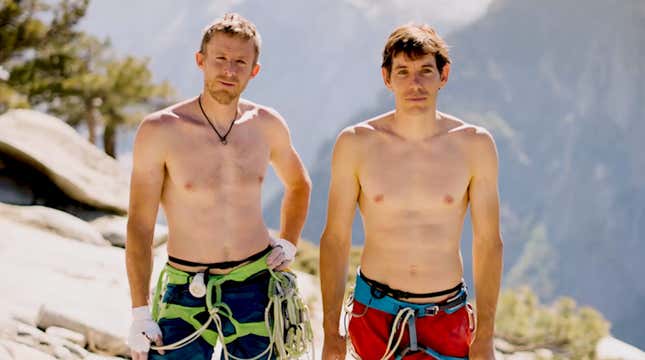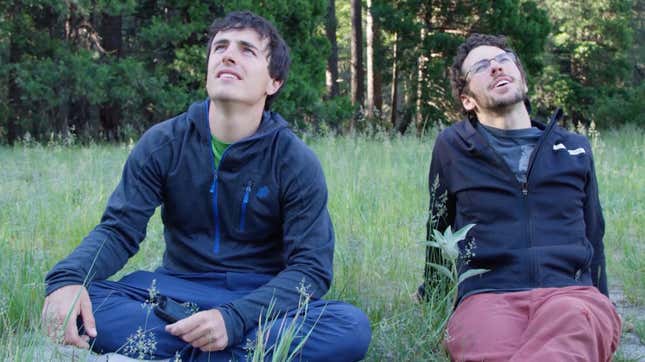
El Capitan was first climbed by Warren Harding, Wayne Merry, and George Whitmore in 1958. They climbed The Nose route over the course of a year, and it took them 47 days of actual climbing to reach the summit using “siege” tactics. In the intervening six decades, The Nose has established itself as the most famous big wall route in the entire world, in the process transforming from a foreboding summit merely to be reached into a racetrack of sorts for the best climbers in the world. The movie The Nose Speed Record tells the story of the first two men to climb the route in less than two hours.
The history of The Nose is a history of vertical racing. Royal Robbins led a crew up the route two years later, and it took them a week. By 1975, John Long, Jim Bridwell, and Billy Westbay completed all 2,900 feet in 24 hours. Lynn Hill made the first free ascent in 1993, and right around that time, Bay Area legend Hans Florine ushered in the modern era of speed climbing when he went under 10 hours and began trading new records back and forth with several rival teams, until it settled in around just under three hours and the pursuit of new records came down to mere seconds. The two-hour barrier has been considered a mythic milestone, and Alex Honnold and Tommy Caldwell’s effort to break that barrier was the subject of the headlining film of this year’s Reel Rock 14 film tour.
Honnold, the most famous climber of his generation, free-soloed Freerider and became the first person to climb El Capitan without ropes. Before he completed that historic ascent, he and Florine held one of the longer standing Nose speed records at 2:23:46. However, a pair of hilarious dirtbags, Brad Gobright and Jim Reynolds, smoked it by four minutes in 2017. The Nose Speed Record focuses on Honnold’s quest to recapture the record.
To prepare, Honnold enlists the help of Tommy Caldwell, perhaps the second-most famous big-wall climber in the world. Caldwell’s own historic free ascent of El Capitan’s most difficult route was captured in last year’s The Dawn Wall. There isn’t a more well-equipped pair of superstar climbers to push for the record, which makes their contrast with Gobright and Reynolds that much better. Unlike Honnold and Caldwell, Gobright and Reynolds are jocular and relaxed. They are clearly there to have fun, not necessarily push the limits of human performance like their counterparts.
The Nose Speed Record magnificently captures the balls-out finale of their record-breaking ascent as they blitz through the final pitch with no gear clipped in between them, Gobright frantically grabbing on to anchors to keep up with his partner. Reynolds says he was planning to clip in the shared rope to an anchor close to the top, but he sensed how thin the margin to breaking the record was, so instead he yelled down to Gobright, “No gear! No falls!” A fall would have meant 2,850 or so feet of Yosemite air between the pair and a violent death, but they avoided disaster, captured the new record, and shocked the climbing world.
Right after the film shows the dirtbag pair’s record breaking effort, Honnold and Caldwell watch a time-lapse video of Gobright and Reynolds at the summit, and they raise eyebrows at their recklessness and chortle about how sketchy the final sequence looked. “Yeah, it’s sketchy,” Gobright says with a smirk, “but that’s why I’ve got the record and you don’t.” He knows Honnold will most likely steal his record, but the sense of genuine competitiveness enlivens the film. Honnold is an athlete driven by a monomanical pursuit of perfection, a necessary trait to do what he does, and Gobright and Reynolds clearly revel in putting one over on the king of Yosemite. Caldwell takes a 50-foot fall in an early attempt, and Gobright can’t help but giggle, clearly pleased that the two famous professionals can’t simply fly in to the Valley and crack records easily.
Still, this is climbing, not war, and Gobright and Reynolds happily help out the effort. Reynolds, a Yosemite search-and-rescue worker, assists the Reel Rock camera crew and lightly heckles Honnold on the wall, though the last thing anyone involved wants is a serious fall. Gobright and Reynolds are a supportive version of Statler and Waldorf, and I wish they were featured more heavily in the final half of the movie. As with Free Solo, the inherent danger of the pursuit is the emotional counterweight to the clear joy every person involves takes from climbing the wall, and nobody seemed to take more joy than those two heckling oddballs.
The rules of speed climbing are simple: Get up the wall as fast as you can. Use aid climbing techniques, grab the bolts on the wall, and, as Honnold says, “cheat.” The presence of ropes and safety devices (Honnold wears a helmet and gets lightly ribbed for it) is a marked departure from Free Solo, and it’s a different sort of climbing. Rather than the actuarial precision Honnold required to free solo the rock, breaking The Nose speed record is more about achieving a flow state and gunning it as fast as your bond with your partner allows. That usually involves using as little gear as possible. “To say it’s safe would be a total lie,” Gobright says. “It’s not that safe.”

It really isn’t: Just before Honnold settled in for his assault on the record, Florine took a nasty fall and shattered both of his heels. His surf-bum Obi-Wan presence in the film is a good reminder that pushing these particular sorts of limits is not without consequence. One of Caldwell’s neighbors fell off the boot flake and shattered her back. Reynolds rescued her. The day after Caldwell and Honnold first broke the record, two men died on The Nose.
A climber can do everything right and still die in a place as precarious as El Capitan, and what energizes The Nose Speed Record is the dance between absolute human performance and the endemic messiness of big wall climbing. El Capitan is an inhuman place. Conquering it, the film argues, takes inhuman effort. Caldwell’s two kids play at the foot of the wall while he enters the maelstrom, and the stakes feel severe for both men.
It is no secret that Honnold and Caldwell eventually broke the two-hour mark; that much should be obvious from the title card. The story itself is fairly straightforward, and if you’ve seen Free Solo, you know what you’re getting yourself into. Still, Honnold is such a singular force that it’s enthralling to watch him bring Caldwell into his mania. Right after they break the record for the first time, Honnold tells his partner, “It still wasn’t quite perfect, though.” After the pair accomplishes the climb in under two hours and stands on the summit of one of nature’s most daunting creations, he jokes, “The feeling has passed. I already feel like we kinda suck and we should’ve done better.”